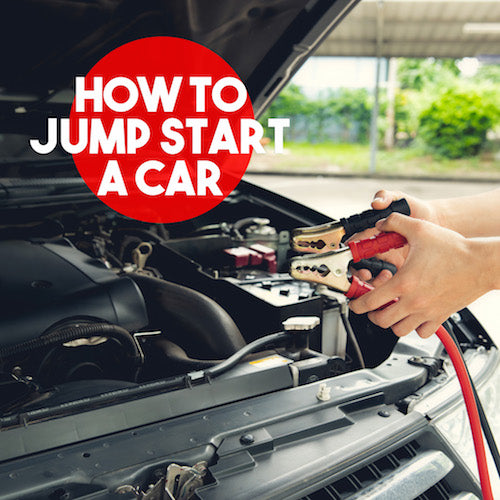Few things can ruin a road trip or your daily commute more than a dead battery. Not only is it frustrating being stranded with a car that can’t move with A/C that can’t turn on and keep you warm or cool, it can be time-consuming waiting for a mechanic or Good Samaritan to arrive.
That is, unless you have the right tools: a power source and a pair of humble jumper cables. With these tools alone, you’ll be able to restart your car’s battery and bring it back to life.
But if you’ve never jump started a car, the process may seem difficult and confusing. Where do the clips attach to? Which terminal is correct? Is this the right one? Why can’t cars just run on a bunch of AA batteries instead?!
If you’re confused, fear not. Jump starting a car is a fairly straightforward process, but one that can come in very handy in any unfortunate emergency situations. It’s a skill that’s better to know but never have to use rather than not know and have to use.
WHAT YOU’LL NEED
As we’ve established, you only need two tools to jump start a car: jumper cables and a power source. Jumper cables are long cables thickly insulated with rubber, featuring toothed metal clips at one or both ends. These clips are known as alligator clips due to their distinct shape.
Jumper cables (and their clips) are always distinguished by color, with red and black being among the most common. The red cable is positive while the black is negative. If you’re unsure which is which, consult a manual or the manufacturer if your cable colors are different than this.
Secondly, you’ll need a power source. If a car or other vehicle is available, you can connect the jumper cables directly to form a circuit between both vehicles’ batteries. This method is fairly straightforward, but there is another way.
If you don’t have another vehicle available, a jump box (essentially a portable battery) will get the job done too. With this method, specialized jump cables are connected directly between the jump box and the dead car battery.
PRECAUTIONS BEFORE YOU START!
Although jump starting a car is generally a straightforward process, that doesn’t mean it can’t be dangerous. Without taking the right precautions or otherwise being careless, you can bring harm to yourself and damage your vehicle.
First, be sure to read your owner’s manual. Not all vehicles can be safely jump started as tested by their manufacturers. Next, check your battery. If there’s any corrosion, leaking, or obvious damage, do not attempt to jump it!
This applies to frozen and dry batteries too. Batteries in either one of these states cannot be safely jump started. Finally, be sure to never touch the clips together when connected.
If you’ve inspected the owner’s manual and batteries and have found it’s safe to jump start your vehicle, it’s now time to take a few further precautions to protect the donor battery. Make sure the donor battery is not low and match its voltage system to the dead battery to be jumped.
STEPS TO JUMPING A CAR
Once you know everything is safe and that both batteries are ready, it’s time to jump! The most critical part of this process is obvious but absolutely key to success: the order in which you perform the necessary steps. Here’s how to do it.
Double check that the donor battery isn’t low and that the voltage system is matching, whether it be 6-volt, 12-volt, or any other type. Turn off the ignition in both vehicles, put them in either park or neutral, and engage the parking brake in both.
Pop open each hood and attach the alligator clips to the correct terminals in this exact order:
- Red to dead: Connect the red (+) clip to the positive terminal of the dead car
- Red to donor: Connect the other red (+) clip to the positive terminal of the donor car
- Black to donor: Connect the black (-) clip to the negative terminal of the donor car
- Black to metal: Connect the other black (-) clip to an unpainted metal part of the dead car that isn’t near the battery
At this point, you’re almost done! Start the donor car, then allow it to idle for a few minutes. Now, you can test if the jump start has worked. Try turning on an interior light, headlight, or even the radio to see if it has some power.
If all has gone well, congratulations, you’ve successfully jump started your car, learned a valuable new skill you can teach your friends and loved ones, and can now safely be on your way to your next destination!
